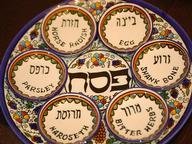Quiz Answer Key and Fun Facts
1. The story of Passover is recorded in Exodus, the second book of the Bible. What is the Hebrew name given to the collection of the five books Genesis, Exodus, Leviticus, Numbers, and Deuteronomy?
2. The adoptive son of the Pharaoh's daughter was commanded by God to demand the freedom of the Israelites. Who was this prophet, also associated with the Ten Commandments?
3. The Israelites were given the land of Goshen in which to live by the Pharaoh of Joseph's time. In which country was the land of Goshen located?
4. Which of the ten plagues was due to occur on the night of Passover?
5. Yahweh commanded that blood from which animal be marked on the doorposts of the homes of the Israelites to ensure that they were protected from the tenth plague?
6. What is the name of the commemorative meal which Jewish families observe on the first night of Passover?
7. One of the traditional items served during the first night of Passover are herbs which are selected to have which flavour, symbolic of the suffering of the people?
8. An item traditionally served during Passover is matzoh, a type of which bread?
9. Which drink is served during Passover, with four glasses expected to be consumed at different stages of the meal?
10. Despite agreeing to let the Israelites leave, Pharaoh changes his mind and pursues them to which body of water, which Moses is traditionally believed to have parted?
Source: Author
Tan72
This quiz was reviewed by FunTrivia editor
LeoDaVinci before going online.
Any errors found in FunTrivia content are routinely corrected through our feedback system.
